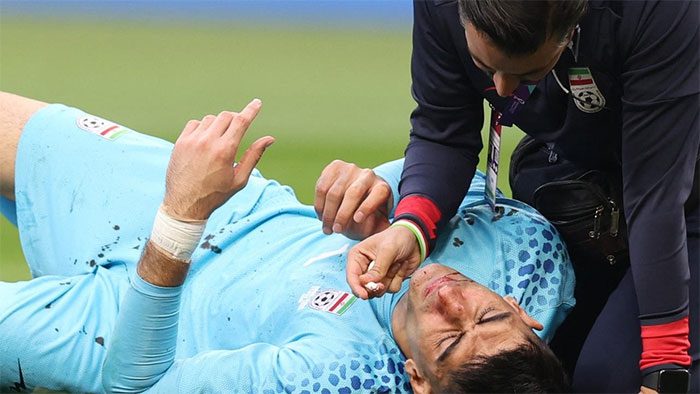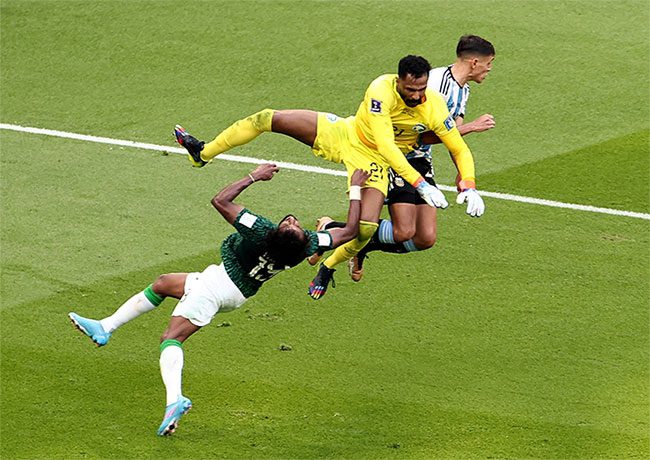In recent years, all sports around the world have begun to emphasize the importance of concussions and their impact on players. Football is no exception.
According to Sporting News, from small leagues to global tournaments like the 2022 World Cup, the world is witnessing the growing popularity of the concussion substitution rule. This regulation allows teams to replace a player showing signs of a concussion without affecting their regular substitution rights.
This rule was immediately applied during the match between Iran and England on the evening of November 21.

Ali Beiranvand lying on the field after colliding with a teammate. (Photo: Advertiser).
What is the Concussion Rule at the 2022 World Cup?
Before the 2022 World Cup kicked off, FIFA confirmed that teams are allowed to make concussion substitutions. This is also the first time it has been implemented at the World Cup.
For a long time, many experts have called for the replacement of players who suffer concussions during collisions. The aim is to prevent health risks for players, ensure fairness for teams losing an injured player, and not affect their regular substitution rights.
This issue became particularly prominent in the football community after the 2014 World Cup final. At that time, German midfielder Christoph Kramer suffered a head injury from a strong collision. He exhibited symptoms of a concussion but could not leave the field. Ezequiel Garay’s shoulder collided with Kramer’s face, nearly incapacitating him.
Kramer continued to play but could only last another 10 minutes before being substituted for Andre Schürrle in the 31st minute due to dizziness. He admitted that he did not remember much about the final against Argentina after sustaining the head injury.
This incident sparked a series of debates. It highlighted the urgent need to assess more serious concussions and establish appropriate protocols to prevent such occurrences.
Many studies have shown that concussions from collisions in sports lead to numerous dangerous consequences. According to The Athletic, players can suffer from secondary cerebral edema and cumulative effects of injury following the initial head trauma. Secondary cerebral edema syndrome occurs when the brain swells rapidly after a person suffers a second injury, before the symptoms of the previous concussion subside. This event is very rare, but when it occurs, it often results in death.

The moment Yasser Al Shahrani (Iran) suffered a serious injury after taking a knee to the head from his own goalkeeper. (Photo: Reuters).
FIFA Regulations at the 2022 World Cup
FIFA released a 21-page document on its official website titled “FIFA Medical Protocol for Concussion – Signs and Protection.”
FIFA stated: “If there are signs or symptoms of brain injury, or suspicion of a concussion even without signs or symptoms, the doctor should remove the player from the field for further evaluation using concussion diagnostic methods.”
Teams are allowed to make 5 substitutions in a match. If a head injury occurs, they can utilize the Additional Permanent Concussion Substitution (APCS) method, according to the guidelines of the International Football Association Board. This does not count against the 5 substitutions allowed per match.
This sounds reasonable, but implementing it is not easy. Medical officials must prioritize a safe approach, but there are no subsequent medical assessment requirements to determine whether the player is fit to continue playing after a collision.
FIFA began trialing this regulation at the FIFA Club World Cup 2021. Since then, several prominent leagues have adjusted to adopt this protocol. Last season, the Premier League also implemented the concussion protocol.
The first concussion substitution in English football occurred on February 6, 2021, when Issa Diop of West Ham was substituted in the first half after a head collision. Initially, he continued to play. However, after further evaluation in the locker room, the medical team concluded that Issa Diop was not fit to play and substituted him out.
Following this incident, the Professional Footballers’ Association praised the concussion substitution rule as a means of protecting the long-term health and safety of players on the field.
According to the regulations, excluding concussion substitutions, teams are allowed to make 5 substitutions in a match at the 2022 World Cup, during 3 different intervals. This number has increased by 2 from the 3 substitutions allowed in previous World Cups before Covid-19.
Additionally, in extra time during knockout matches, teams are also permitted to make one additional substitution, meaning they can make a maximum of 6 substitutions in a match if it goes to extra time.


















































